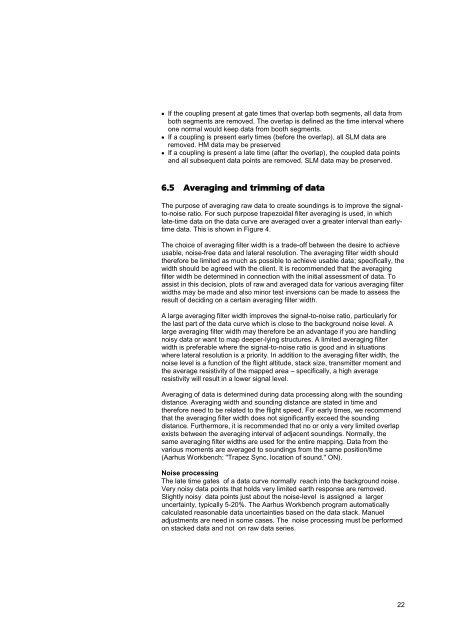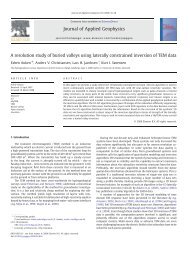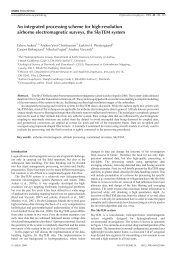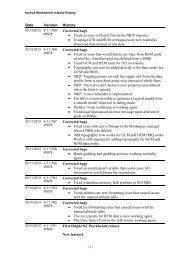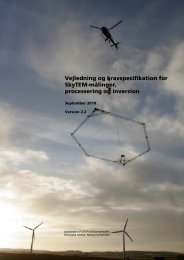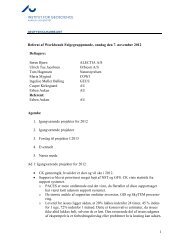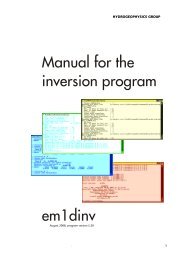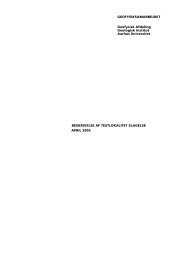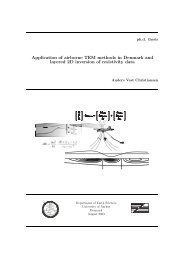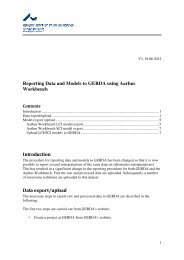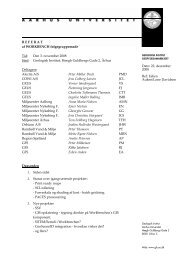guideline and standards for skytem measurements, processing and ...
guideline and standards for skytem measurements, processing and ...
guideline and standards for skytem measurements, processing and ...
You also want an ePaper? Increase the reach of your titles
YUMPU automatically turns print PDFs into web optimized ePapers that Google loves.
If the coupling present at gate times that overlap both segments, all data from<br />
both segments are removed. The overlap is defined as the time interval where<br />
one normal would keep data from booth segments.<br />
If a coupling is present early times (be<strong>for</strong>e the overlap), all SLM data are<br />
removed. HM data may be preserved<br />
If a coupling is present a late time (after the overlap), the coupled data points<br />
<strong>and</strong> all subsequent data points are removed. SLM data may be preserved.<br />
6.5 Averaging <strong>and</strong> trimming of data<br />
The purpose of averaging raw data to create soundings is to improve the signalto-noise<br />
ratio. For such purpose trapezoidal filter averaging is used, in which<br />
late-time data on the data curve are averaged over a greater interval than earlytime<br />
data. This is shown in Figure 4.<br />
The choice of averaging filter width is a trade-off between the desire to achieve<br />
usable, noise-free data <strong>and</strong> lateral resolution. The averaging filter width should<br />
there<strong>for</strong>e be limited as much as possible to achieve usable data; specifically, the<br />
width should be agreed with the client. It is recommended that the averaging<br />
filter width be determined in connection with the initial assessment of data. To<br />
assist in this decision, plots of raw <strong>and</strong> averaged data <strong>for</strong> various averaging filter<br />
widths may be made <strong>and</strong> also minor test inversions can be made to assess the<br />
result of deciding on a certain averaging filter width.<br />
A large averaging filter width improves the signal-to-noise ratio, particularly <strong>for</strong><br />
the last part of the data curve which is close to the background noise level. A<br />
large averaging filter width may there<strong>for</strong>e be an advantage if you are h<strong>and</strong>ling<br />
noisy data or want to map deeper-lying structures. A limited averaging filter<br />
width is preferable where the signal-to-noise ratio is good <strong>and</strong> in situations<br />
where lateral resolution is a priority. In addition to the averaging filter width, the<br />
noise level is a function of the flight altitude, stack size, transmitter moment <strong>and</strong><br />
the average resistivity of the mapped area – specifically, a high average<br />
resistivity will result in a lower signal level.<br />
Averaging of data is determined during data <strong>processing</strong> along with the sounding<br />
distance. Averaging width <strong>and</strong> sounding distance are stated in time <strong>and</strong><br />
there<strong>for</strong>e need to be related to the flight speed. For early times, we recommend<br />
that the averaging filter width does not significantly exceed the sounding<br />
distance. Furthermore, it is recommended that no or only a very limited overlap<br />
exists between the averaging interval of adjacent soundings. Normally, the<br />
same averaging filter widths are used <strong>for</strong> the entire mapping. Data from the<br />
various moments are averaged to soundings from the same position/time<br />
(Aarhus Workbench: "Trapez Sync. location of sound." ON).<br />
Noise <strong>processing</strong><br />
The late time gates of a data curve normally reach into the background noise.<br />
Very noisy data points that holds very limited earth response are removed.<br />
Slightly noisy data points just about the noise-level is assigned a larger<br />
uncertainty, typically 5-20%. The Aarhus Workbench program automatically<br />
calculated reasonable data uncertainties based on the data stack. Manuel<br />
adjustments are need in some cases. The noise <strong>processing</strong> must be per<strong>for</strong>med<br />
on stacked data <strong>and</strong> not on raw data series.<br />
22


